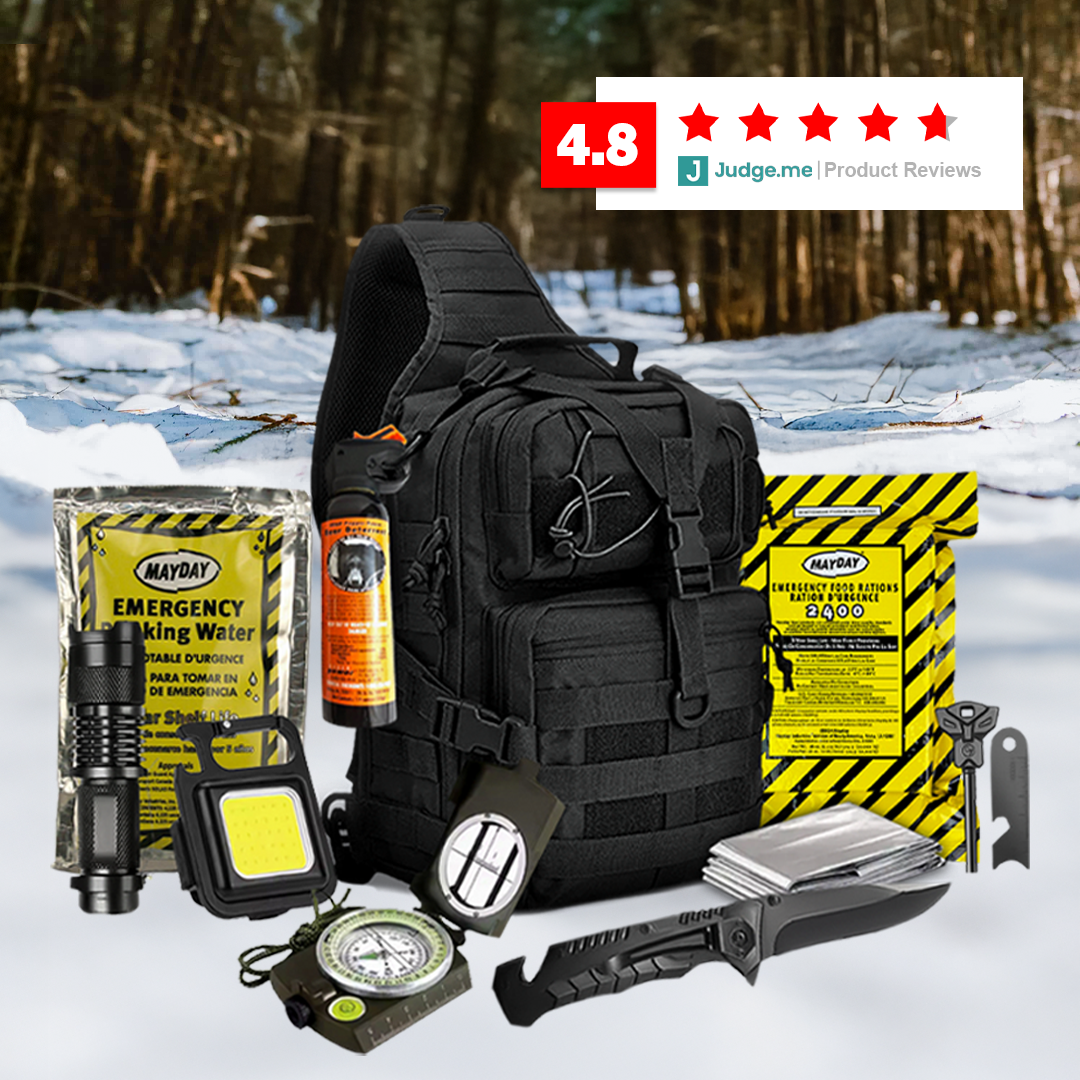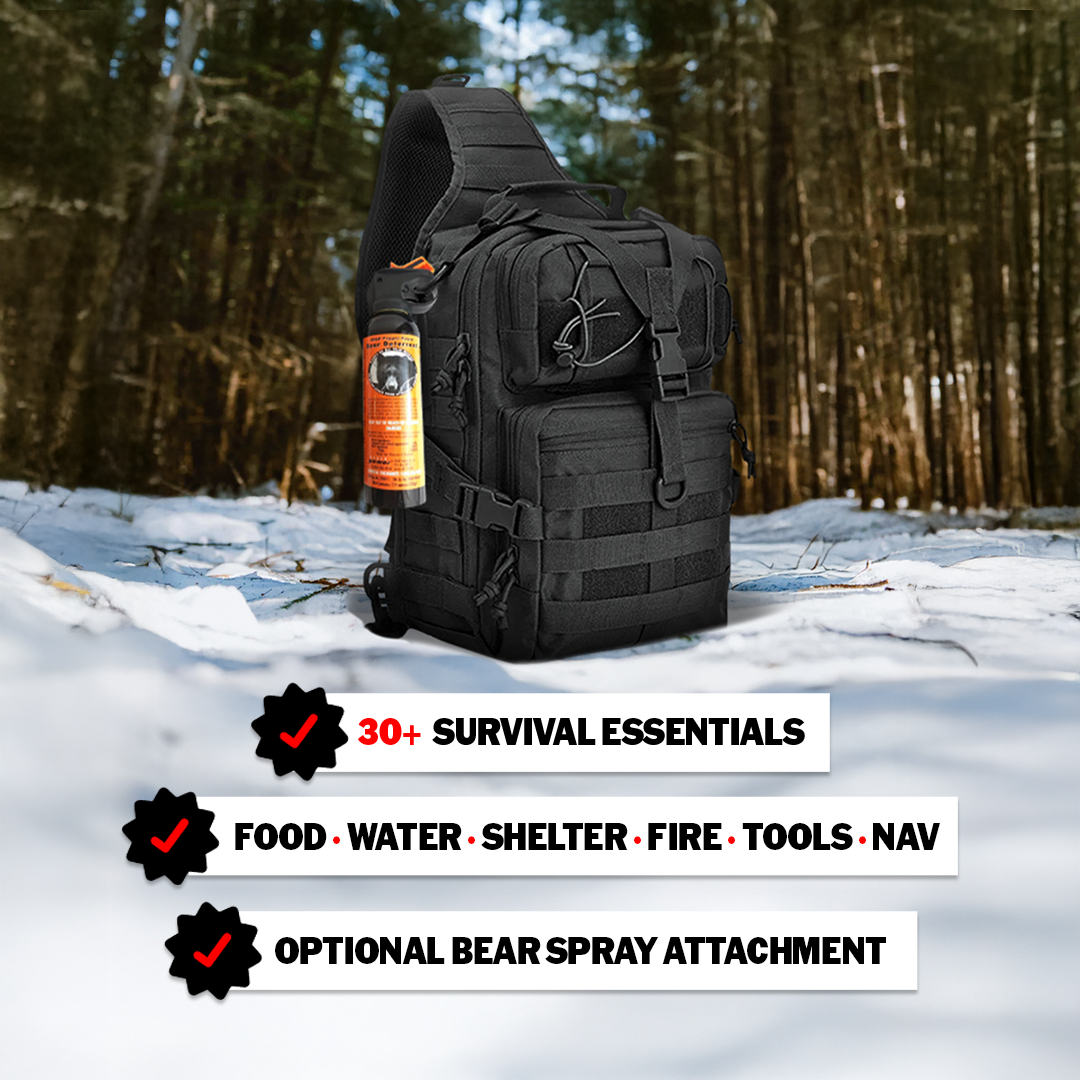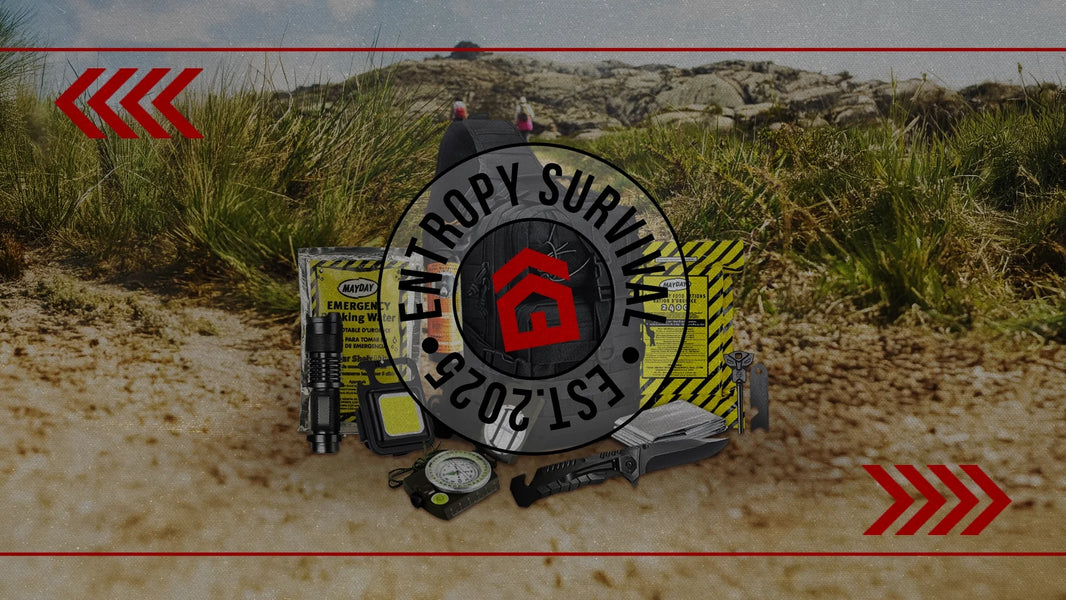Understanding Wildfire Threats in Modern America
Forest fires represent one of nature's most awe-inspiring and terrifying forces. These powerful events can transform lush landscapes into desolate moonscapes within hours, threaten communities, and dramatically alter ecosystems. At Entropy Survival, we've studied wildfire patterns extensively as part of our comprehensive emergency preparedness research, recognizing that understanding these natural disasters forms an essential component of modern survival knowledge.
This guide combines crucial scientific facts about forest fires with practical preparedness strategies drawn from our field experience. By understanding both the natural patterns of wildfires and effective human responses, you'll be better positioned to protect yourself, your family, and your property from these increasingly common threats.
The Science Behind Forest Fires
Forest fires occur when three critical elements combine: fuel (vegetation), oxygen, and an ignition source. This simple formula, known as the fire triangle, explains the fundamental mechanism behind every wildfire. However, the complexity of real-world fire behavior extends far beyond this basic concept.
Wildfire behavior depends on numerous interrelated factors that determine intensity, spread rate, and overall impact. Fuel type significantly influences fire characteristics, with dry grasses producing fast-moving but relatively less intense fires, while dense forest undergrowth creates slower but extraordinarily hot blazes. Topography plays a major role as well, with fires traveling uphill at dramatically accelerated rates, sometimes moving twice as fast on 30-degree slopes compared to flat terrain.
Weather conditions represent perhaps the most significant variable in wildfire behavior. Low humidity, high temperatures, and strong winds create ideal conditions for extreme fire growth. When relative humidity drops below 30%, vegetation becomes exceptionally receptive to ignition. Wind not only accelerates fire spread by supplying additional oxygen but also propels burning embers ahead of the main fire front, creating new ignition points called spot fires that can bypass natural and man-made fire breaks.
According to research analyzed by our emergency planning team at Entropy Survival, climate patterns significantly influence fire seasons and intensity. The relationship between snowpack, spring temperatures, and summer drought conditions creates predictable patterns of fire risk that vary by region. Understanding these patterns allows for strategic preparation during lower-risk periods, a principle we emphasize in our comprehensive Bug Out planning methodology.
Startling Forest Fire Statistics
Recent years have witnessed unprecedented wildfire activity across North America and globally. The scale of modern fires has shattered historical records, creating new benchmarks for what constitutes "extreme" fire behavior.
In the United States alone, wildfires burn an average of 7 million acres annually, more than double the annual average from the 1990s. The 2020 fire season proved particularly devastating, with over 10.1 million acres burned, exceeding the 10-year average by more than 50%. California's August Complex Fire alone consumed over 1 million acres, becoming the state's first "gigafire" in modern history.
The financial impact of these events reaches staggering proportions. Annual suppression costs regularly exceed $2 billion in the United States, while total economic impacts including property damage, lost revenue, and healthcare costs often surpass $20 billion. The 2018 Camp Fire in California generated over $16.5 billion in losses alone, making it the costliest disaster worldwide that year.
Human casualties from wildfires, while lower than many other natural disasters, remain significant. Between 2017 and 2021, U.S. wildfires directly caused over 200 civilian fatalities. However, smoke-related health impacts affect far more people, with studies suggesting that wildfire smoke contributes to thousands of excess deaths annually, particularly among vulnerable populations with respiratory conditions.
The increasing prevalence of what fire scientists call "wildland-urban interface" (WUI) fires represents a particularly troubling trend. These fires occur where developed areas meet or intermingle with undeveloped wildlands, putting over 44 million homes across the United States at elevated risk. Our vulnerability assessments at Entropy Survival have identified WUI areas as particularly high-priority for comprehensive preparedness planning.
Human Impact on Forest Fire Patterns
While lightning triggers many forest fires, particularly in remote wilderness areas, human activity remains the predominant ignition source. According to National Park Service data, humans cause approximately 85% of wildland fires in the United States through a variety of activities that generate heat or sparks.
Campfires left unattended or improperly extinguished represent one of the most common humanrelated ignition sources. Despite widespread public awareness campaigns, thousands of wildland fires originate from recreational fires each year. Equipment use, particularly during dry conditions, constitutes another major source, with lawn mowers, chainsaws, and other power equipment creating sparks that ignite surrounding vegetation.
Discarded cigarettes, though less common than popularly believed, still cause hundreds of wildland fires annually. Perhaps most disturbing, intentional arson accounts for roughly 10% of wildland fires annually, with some of the most destructive events attributed to deliberate human action.
Human impact extends beyond direct ignition to broader environmental changes that influence fire behavior. Our emergency ecology research at Entropy Survival has identified several critical human-influenced factors that increase wildfire risk and intensity:
Fire suppression policies implemented throughout the 20th century, while well-intentioned, resulted in unnatural fuel accumulation in many forest ecosystems. By preventing smaller, natural fires, these policies inadvertently created conditions for catastrophic megafires once ignition occurs. Many forest management experts now advocate for controlled burns that mimic natural fire cycles while reducing dangerous fuel loads.
Climate change represents another significant human influence on fire patterns. Rising average temperatures extend fire seasons, with many regions now experiencing "fire years" where potential burn conditions exist throughout much of the calendar year. Changing precipitation patterns, including more intense but less frequent rainfall events, create boom-and-bust vegetation cycles that increase fire danger.
Invasive species introductions have dramatically altered fire regimes in many ecosystems. Plants like cheatgrass in the Western United States create continuous, highly flammable fuel beds that enable rapid fire spread across landscapes that historically had natural fire breaks. These invasive grasses burn more readily and recover more quickly than native vegetation, creating selfreinforcing cycles of increasing fire frequency.
Ecological Role of Forest Fires
Despite their destructive potential, forest fires play essential ecological roles in many environments. Numerous ecosystems have evolved with fire as a natural, recurring process that maintains overall health and diversity. Understanding this ecological context helps explain why complete fire suppression often proves counterproductive and ultimately increases long-term risk.
Many North American tree species display remarkable adaptations to fire. Ponderosa pines develop thick, insulating bark that protects them from moderate fires. Jack pines and lodgepole pines produce serotinous cones that remain sealed by resin until fire's heat releases their seeds, ensuring regeneration specifically after fire events. Giant sequoias rely on periodic fires to clear competing vegetation and prepare mineral soil for their tiny seeds.
Fire supports nutrient cycling in forest ecosystems by converting organic matter into mineral-rich ash that replenishes soil. This process can temporarily increase soil fertility and stimulate vigorous plant growth in the seasons following a fire. The mosaic of differently-aged vegetation created by patchy burns increases habitat diversity, supporting more varied wildlife populations than uniformly aged forests.
Indigenous cultures across North America recognized these beneficial aspects of fire and developed sophisticated burning practices that maintained ecosystem health while reducing catastrophic fire risk. Many modern forest management approaches now incorporate lessons from these traditional ecological knowledge systems, including the strategic application of prescribed fire.
Our environmental assessment protocols at Entropy Survival incorporate understanding of these natural fire cycles when evaluating property vulnerability and developing mitigation strategies. Recognizing which local ecosystems evolved with frequent fire helps determine appropriate landscaping and building protection measures, a principle we apply in our comprehensive property evaluation services.
Forest Fire Prevention Strategies
Preventing unwanted forest fires requires both individual responsibility and collective action. While completely eliminating wildfire risk remains impossible, practical measures can significantly reduce ignition probability and limit potential damage when fires do occur.
At the individual level, practicing proper fire safety during outdoor activities makes a substantial difference. This includes building campfires only in designated areas with proper clearance, keeping fires reasonably sized, attending them continuously, and ensuring complete extinguishment before leaving. Our field tests have shown that properly extinguished campfires should feel cool to the touch, not merely free of visible flames.
Equipment maintenance plays a crucial role in preventing accidental ignitions. Ensuring that vehicles have properly functioning exhaust systems, avoiding parking on dry vegetation, and maintaining spark arrestors on outdoor power equipment significantly reduces fire risk. During high fire danger periods, postponing non-essential yard work involving power equipment represents the safest approach.
Property owners in fire-prone areas can implement defensible space principles to protect structures and create firebreaks. This involves strategically reducing vegetation around buildings, particularly removing "ladder fuels" that allow flames to climb from ground level into treetops. The concept of defensible space aligns perfectly with our multi-zone protection philosophy at Entropy Survival, where we advocate creating concentric rings of increasing protection around critical assets.
Community-level prevention efforts include strategic forest management practices like selective thinning, prescribed burning, and creating fuel breaks around vulnerable areas. Supporting proper funding for these activities through civic engagement helps reduce community-wide risk. Many regions also implement seasonal fire restrictions based on current conditions, temporarily prohibiting activities like outdoor burning, fireworks, or certain equipment use during dangerous periods.
Public education represents another crucial prevention strategy, with awareness campaigns helping residents understand local fire risks and appropriate responses. Our emergency preparedness workshops at Entropy Survival emphasize this knowledge-based approach, recognizing that informed communities make better decisions before, during, and after wildfire events.
Forest Fire Survival Strategies
When forest fires threaten despite prevention efforts, having clear survival strategies becomes essential. Our wilderness survival experts at Entropy Survival have developed comprehensive approaches for various wildfire scenarios, drawing on both scientific research and practical field experience.
Evacuating Safely from Wildfire Zones
Early evacuation represents the safest response when wildfires threaten populated areas. Official evacuation orders should never be ignored, as they indicate imminent danger based on fire behavior predictions from experienced incident commanders. However, rapidly developing fires sometimes require independent decision-making before official notices arrive.
Recognizing early warning signs of potential fire danger allows for proactive evacuation before conditions deteriorate. Unusual smoke columns, particularly those displaying rapid vertical development or changing colors, warrant immediate attention. The sound of approaching fire, often described as a freight train rumble, indicates imminent threat requiring immediate action.
Evacuation preparation follows principles similar to our Bug Out methodology at Entropy Survival. Having essential documents, medications, irreplaceable items, and emergency supplies pre-organized in easily accessible locations significantly reduces evacuation time. Our research indicates that many wildfire fatalities occur during last-minute evacuations when preparation proves inadequate.
Vehicle preparation plays a crucial role in safe evacuation. Maintaining at least half a tank of fuel at all times during fire season provides essential range for unexpected evacuation needs. Positioning vehicles facing exit routes and keeping emergency supplies inside creates additional readiness. The vehicle emergency kits included in our Safe House system incorporate specialized items for wildfire situations, including respirator masks for smoke protection.
Knowing multiple evacuation routes, including secondary and tertiary options, proves essential when primary routes become compromised. Our mapping exercises with clients emphasize identifying these alternatives in advance, focusing particularly on routes that move downhill and downwind from likely fire paths. Practice evacuations during calm conditions help families identify potential bottlenecks or challenges before actual emergencies.
Shelter-in-Place Strategies When Evacuation Isn't Possible
While evacuation remains preferable, certain situations may necessitate sheltering in place during wildfire events. Rapid fire growth, blocked evacuation routes, or physical limitations sometimes make staying put the safer option. Understanding proper shelter-in-place techniques can prove lifesaving in these scenarios.
Building preparation forms the foundation of successful sheltering. Moving flammable materials away from structures, closing all windows and vents to prevent ember entry, and filling available containers with water creates basic readiness. Removing flammable window coverings, moving furniture away from windows, and turningrek on interior and exterior lights improves visibility and reduces ignition sources.
During active fire conditions, sheltering in the portion of the structure farthest from approaching flames provides additional protection. Staying low where air remains clearer and using wet towels to seal door gaps helps manage smoke exposure. Maintaining awareness of multiple exit options remains essential, as conditions can change rapidly, sometimes requiring relocation despite initial shelter-in-place decisions.
For outdoor entrapment situations where structures aren't available, identifying areas with minimal vegetation provides the best protection. Depressions in the ground, areas already burned (if completely extinguished), or large rocky areas offer relative safety. In truly dire situations, our survival training teaches creating small cleared areas and using emergency fire shelters if available, though these represent absolute last-resort options with significant limitations.
The communications equipment included in our Entropy Survival kits provides critical capabilities during wildfire emergencies, allowing contact with emergency services even when conventional systems fail. Battery-powered radios with NOAA weather functionality provide crucial updates when internet and cellular networks become compromised, a common occurrence during major fire events.
After the Fire: Recovery and Rebuilding
The aftermath of forest fires presents distinct challenges requiring specialized knowledge and preparation. Post-fire environments contain numerous hazards while simultaneously demanding immediate action to prevent secondary damage and begin recovery.
Initial property assessment should occur only after official authorities declare areas safe for return. Our post-disaster protocols emphasize checking for hazards like weakened trees that might fall, compromised building structures, damaged utility lines, and hot spots that could reignite. The specialized tools included in our comprehensive preparedness kits facilitate these assessments while minimizing risk.
Water systems often suffer contamination following wildfires, as chemicals from firefighting efforts, ash, and debris enter reservoirs and distribution networks. Having independent water purification capabilities, a core component of our water security approach at Entropy Survival, proves invaluable during these periods. Testing water sources before resuming normal use represents an essential precaution, even with apparent infrastructure restoration.
Soil stabilization becomes an urgent priority in burned areas, particularly before rainfall events that could trigger devastating mudslides. Simple techniques like placing straw wattles perpendicular to slopes, seeding with appropriate native species, and installing temporary barriers can reduce erosion while vegetation recovers. Our environmental restoration partners offer specialized guidance for these applications based on specific site conditions.
Documenting damage thoroughly supports insurance claims and disaster assistance applications. Our documentation methodology includes systematic photography, detailed written descriptions, and comprehensive inventories of affected property. Having these records stored securely off-site or digitally backed up ensures availability when needed for recovery processes.
The psychological impact of wildfire experiences requires acknowledgment and appropriate response. Research indicates that many survivors experience significant stress reactions following these events, with some developing longer-term challenges requiring professional support. Our holistic preparedness approach includes resources for psychological resilience, recognizing that complete preparation addresses both physical and mental wellbeing.
Climate Change and the Future of Forest Fires
Scientific consensus indicates that climate change is significantly influencing wildfire patterns worldwide, with particularly pronounced effects in western North America. Understanding these trends helps inform both immediate preparedness decisions and longer-term adaptation strategies.
Research compiled by our environmental assessment team shows that warming temperatures extend fire seasons in most regions, with spring arriving earlier and fall lingering longer. These expanded fire seasons provide more opportunities for ignition while simultaneously stretching firefighting resources across longer operational periods. In some areas, traditional fire "seasons" have effectively transformed into year-round fire potential.
Changing precipitation patterns create complex fire dynamics that vary by region. In some areas, increased winter and spring rainfall promotes vigorous vegetation growth that subsequently becomes available fuel during dry periods. In other regions, persistent drought conditions stress vegetation, increasing flammability and vulnerability to ignition. The "climate whiplash" between wet and dry extremes creates particularly dangerous conditions.
Temperature increases directly affect wildfire behavior through multiple mechanisms. Higher temperatures increase evaporation rates, drying fuels more rapidly. They also reduce relative humidity, further enhancing fire receptivity. Our field measurements have documented alarming trends in fuel moisture content, with historically unprecedented drying rates recorded in several western forest ecosystems.
Ecological shifts driven by climate change further complicate fire dynamics. Tree mortality from drought, insect outbreaks, and pathogens creates massive fuel accumulations in affected forests. Vegetation community changes, including transitions from forest to shrubland in some regions, alter historical fire behavior patterns. These shifts require corresponding adaptations in fire management and preparedness approaches.
While the implications of these trends appear daunting, practical adaptation strategies exist at both individual and community levels. Our adaptation consultations emphasize actions like creating climate-resilient defensible spaces using drought-tolerant, fire-resistant landscaping appropriate for projected future conditions rather than historical patterns. Building or retrofitting structures with non-combustible materials, particularly roofing and siding, provides increasing value as fire risk intensifies.
Preparing Your Home and Family for Forest Fire Threats
Creating comprehensive wildfire preparedness requires systematic planning and implementation. Our experience at Entropy Survival has identified several key areas where focused preparation yields maximum protection.
Home hardening represents a primary defense against ember ignition, the most common mechanism of structure loss during wildfires. This process involves identifying and modifying vulnerable components like vents, eaves, decks, and windows to resist ember entry and ignition. Simple modifications like installing 1/8-inch metal mesh over vents, replacing wooden fence sections connected to houses, and removing flammable material from roof valleys significantly reduce structure ignition probability.
Landscape management follows defensible space principles but extends beyond basic vegetation removal to include strategic placement of fire-resistant plants, creation of fuel breaks, and maintenance of transition zones between wildlands and developed areas. Our landscape assessment process identifies both hazards and opportunities specific to each property's unique characteristics and location.
Insurance adequacy review ensures financial protection matches actual risk exposure. Many homeowners discover significant coverage gaps only after fires occur, particularly regarding extended replacement costs, temporary living expenses, and specialized property documentation requirements. Our insurance specialists help clients navigate these complexities before emergencies occur, preventing devastating financial surprises during recovery.
Family emergency planning incorporates wildfire-specific elements into comprehensive preparation. This includes establishing communication protocols, designating meeting locations, preparing evacuation routes and alternatives, assembling appropriate emergency supplies, and conducting regular practice drills. The communications equipment in our Safe House Kit provides redundant capabilities specifically designed to function during infrastructure disruptions common in wildfire events.
Community engagement amplifies individual preparedness efforts through collective action. Programs like Firewise USA offer frameworks for neighborhood-level cooperation that dramatically improve overall resilience. Our community preparedness workshops facilitate these collaborative approaches, recognizing that individual properties exist within broader vulnerable landscapes requiring coordinated protection.
Final Thoughts: Resilience Through Knowledge and Preparation
Forest fires represent a growing threat across many regions, influenced by both human activity and changing climate patterns. However, understanding these dynamics empowers effective preparation and response that significantly reduces vulnerability.
At Entropy Survival, our approach to wildfire preparedness exemplifies our broader emergency readiness philosophy: combining scientific knowledge with practical implementation to create genuine resilience. By understanding fire behavior, implementing appropriate preventive measures, developing clear response plans, and preparing for recovery challenges, individuals and communities can face wildfire threats with confidence.
The increasing frequency and intensity of forest fires underscores the importance of proactive preparation rather than reactive response. Just as our comprehensive Bug Out methodology emphasizes readiness before emergencies occur, effective wildfire preparation requires advance planning and implementation during calmer periods. This forward-looking approach transforms potential victims into prepared survivors capable of protecting themselves, their families, and their communities.
For those seeking additional guidance on wildfire preparedness specific to their situation, our specialized consultation services provide personalized assessment and recommendations. From property evaluation to evacuation planning, our experienced team offers practical solutions based on both scientific research and real-world emergency experience.
Understanding forest fires, preparing effectively for their threat, and knowing how to respond when they occur represents an essential component of modern resilience, particularly in vulnerable regions. With proper knowledge and preparation, even this increasingly common hazard becomes manageable through the principles of comprehensive readiness that form the core of the Entropy Survival approach.
Make sure to check out more articles in our News & Views section. Feel free to reach out any time to see how Entropy Survival can help you prepare you and your family for any disaster or survival scenario.

















